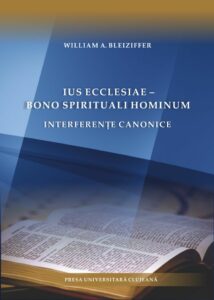Reading Time: 6 minutes
Con il patrocinio dell’Università di Cluj-Napoca è stato reso omaggio all’opera di Padre Maximilian Pal. Professore di diritto canonico presso l’Istituto Teologico Francescano Romano Cattolico di Roman, dedicando questo volume in occasione del 25° anniversario della ricerca scientifica e dell’insegnamento dei corsi di diritto canonico[1].
Lo ricorda il Vescovo di Iași, Iosif Păuleț, “Padre Pal ha avuto la gioia di vivere proprio questa vocazione di insegnante e non la professione di insegnante”[2]. Un insegnante deve essere in grado di trasmettere nozioni e principi fondamentali in modo che l’allievo possa diventare creativo e non un semplice imitatore. L’insegnante che risponde alla sua vocazione sa godere dei loro successi insieme agli studenti. Un buon insegnante si concentra sulla formazione delle menti di coloro con cui lavora, li allena, insegna loro come pensare e non cosa pensare. La vocazione di un insegnante è la capacità di dialogare, di essere aperti alle domande, di avere uno sguardo affettuoso verso qualcuno che osa presentare o presentare qualcosa, anche se non è accademico.
“Padre Pal aveva questa sacra missione di collocare ogni studente nello spazio della sua identità”[3], spiega il Vescovo di Iași “gli studenti del Seminario che si stavano preparando a vivere lo spirito di San Francesco, sia come sacerdoti che come fratelli, hanno avuto l’opportunità di essere plasmati come „argilla nelle mani del vasaio”, dopo l’immagine usata dal profeta Geremia, da padre Maximilian”[4]. Egli ha saputo riconoscere in ciascuno dei suoi studenti la sua specificità e unicità, riuscendo a guidarli.
Padre Maximilian è nato il 4 agosto 1962 a Nisiporești, nella provincia di Neamț in Romania, primo di nove figli dei genitori Ioan e Tereza Pal. I germi della vocazione al sacerdozio si radicano nella famiglia e prendono forma nella sua adolescenza. Insieme alla famiglia, fattore essenziale per maturare la propria vocazione sono i pastori della comunità parrocchiale che ne danno testimonianza. Come ricorda Sua Eccellenza Anton Coșa, Vescovo di Chișinău, “lo incontrai per la prima volta nell’estate del 1979, all’esame di ammissione al Seminario Cattolico Romano di Iași. Per nove anni condividemmo tutte le attività inerenti alla vita del Seminario: formazione umana, spirituale e intellettuale, prima a livello di corsi di liceo nel Seminario Piccolo e poi, dopo nove mesi di servizio militare, la laurea universitaria all’interno dell’Istituto Cattolico Romano di Iași. Potrei dire che in questi anni di formazione siamo cresciuti e maturati insieme. Il nostro collega, padre professor Maximilian, ha scelto in cuor suo di diventare francescano, quando l’alba della libertà religiosa era appena visibile nel Paese”[5].
Nel 1991 viene inviato dai suoi superiori a seguire i Corsi di specializzazione presso la Pontificia Università Lateranense, iscrivendosi all’Istitutum Utriusque Iuris dove consegue la Laurea magistrale in diritto canonico e civile con la tesi: Natura ed effetti giuridici dell’errore di ignoranza in Diritto bizantino e nell’attuale legislazione della Chiesa. Segue anche a Roma i corsi di diritto canonico all’interno della Congregazione della Curia Romana per gli Istituti di Vita Consacrata e delle Società di Vita Apostolica, della Congregazione per il Culto Divino e la Disciplina dei Sacramenti, nonché i Corsi presso lo Studio Rotale. Presso l’Università Lateranense, il 2 dicembre 2002 con le conoscenze accumulate, padre Massimiliano ha concluso i suoi studi con una tesi di dottorato in entrambi i diritti (utroque iure): „Error juris” e „error facti” nel momento giuridico negoziato tra fonti normative romane e fonti bizantine, sotto il coordinamento del Professor Onorato Bucci.
A seguito della competenza acquisita, Padre Massimiliano, fu chiamato ad insegnare le materie di Diritto Canonico e Prassi Matrimoniale Canonica presso la Facoltà di Teologia Pastorale all’interno dell’Istituto Teologico Francescano Romano Cattolico di Roma.
Nel 2004, Sua Eccellenza Petru Gherghel, vescovo titolare di Iași, lo ha nominato Giudice presso il Tribunale Diocesano di Iași, e nel 2007 è stato chiamato da Sua Ecc.za Ioan Robu, arcivescovo e metropolita di Bucarest, a guidare, in qualità di Rettore, l’Istituto Teologico Romano-Cattolico “Santa Tereza” di Bucarest.
Nel suo intervento il Prof. Emilian Roman della Facoltà di Teologia Ortodossa di Iași, sottolinea come rimase colpito da Padre Pal per la sua personalità, precisione e erudizione con cui esponeva qualsiasi questione, ma soprattutto dal tono didattico con cui Padre Pal ripeteva che un’opera di diritto è sempre redatta a partire dalle fonti e che i suoi contributi fondamentali al diritto canonico comparato, nonché la moltitudine di direzioni tematiche proposte per diventare fontes iuris siano fondamentali per le future generazioni di canonisti[6].
L’omaggio all’opera di Padre Pal si compone di diversi contributi, ognuno dei quali assume una valenza particolare.
Il Cardinale Coccopalmerio ricorda che “L’opera di Padre Ivan Žužek non si è limitata ai lavori di competenza del suo ufficio”. Egli infatti veniva interpellato con richieste di studi e pareri personali di grande riservatezza da parte della Segreteria di Stato o della Congregazione per le Chiese Orientali[7].
Il Prof. Onorato Bucci che ebbe l’onore di conoscere Žužek, e ne ricorda che nel lontano 1966, accompagnato dai Proff. Edoardo Volterra, Olis Robleda e Pietro Tocănel in occasione della laurea dell’attuale Patriarca Ecumenico Bartolomeo Archondonis come ne rimase amico per ben trentotto anni[8]. Il Prof. Bucci pone l’attenzione, essendone stato testimone personalmente dell’amarezza e la preoccupazione di padre Žužek sul problema irrisolto nella Chiesa cattolica dello ius personarum con lo ius loci che “è il vero nodo che va sciolto per la regolamentazione dei rapporti fra fedeli delle Chiese orientali cattoliche e fedeli di rito latino della stessa Chiesa cattolica e del ruolo da dare e da attribuire ai Patriarchi e agli Arcivescovi Maggiori sulle Comunità viventi nella Diaspora”[9]. Infatti, conclude il suo prezioso intervento: “Padre Žužek ha lottato tutta la sua vita per questo iter scientifico, la Chiesa Latina si salva solo attraverso le Chiese Orientali, scomparse queste ultime scomparirà anche la Chiesa Latina”.
Mons. Vincenzo Apicella riporta i suoi ricordi su padre Žužek rammentando la sua opera di pastore e di educatore con “l’intento di accompagnare i giovani alle fonti della Rivelazione, specificamente, alla familiarità con la Scrittura Sacra, per un incontro personale e diretto con il Signore”. E di quando padre Žužek allenava i suoi scout a cercare nella natura simboli adattabili a comporre immagini sacre. “Il bosco, la sorgente, le vallate, le vette e i ghiacciai, il cammino sono realtà che hanno una presa evocativa diretta e immediata sui giovani a cui padre Ivan si rivolgerà”[10].
“Questo permette di insegnare a leggere il Liber naturae prima e insieme al Liber Scripturae, poiché la grandezza, la purezza e la semplicità di Dio e della sua sapienza sono inscritte in tutto il creato che ci circonda e di cui facciamo parte”[11].
Negli studi in onore di Maximilian Pal importante menzione si deve allo studio di p. Damian-Gheorghe Pătrașcu per aver evidenziato il posto e la missione del Pontefice Romano all’interno della gerarchia ecclesiastica[12]; Romeo Neculai che bene ha evidenziato gli aspetti dell’esercizio della potestà nella Chiesa: “ogni società ha bisogno di un Governo; I membri di una società hanno il diritto di essere equamente governati da coloro che hanno ricevuto questa missione, di conseguenza, chi ha il compito di governare deve possedere anche la forza richiesta”[13]; Traian Radu Coste Deak per la sua opera divulgativa sul concetto dell’autonomia ecclesiastica nella Chiesa Romena Unita con Roma[14]; William Bleiziffer per aver evidenziato gli aspetti canonici della superiore autorità ecclesiastica della Chiesa Greco Cattolica Rumena[15]. Con il contributo su “il droit de joyeux avènement” il Prof. Alessandro Bucci sottolinea la libertà della Chiesa Franca “che si governava in relazione alla sede romana, fanno logicamente pensare che questo diritto, nato dalla signoria feudale sul suolo, sia stato conservato attraverso i secoli come uno dei mezzi per conservare questa libertà[16]. E conclude che “la scomparsa dell’esercizio del droit de joyeux avènement dai monasteri, si spiega con il fatto che i sovrani l’abbiano lasciato estinguere semplicemente con il non uso”. Il più moderno diritto di inviare un “oblat à chaque monastère” probabilmente può essere spiegato con il non aver voluto, da parte del sovrano, gravare troppo sui monasteri quando questo nuovo diritto iniziò a essere esercitato[17]. Di particolare interesse con osservazioni sul concetto di Sinodalità e primato è il contributo di Irimie Marga dal titolo “Espressione di amore e giustizia, in armonia”[18]; Constantin Rus per il suo lavoro sulle norme canoniche relative alla concessione di Epitimia[19]; Simone Osvaldo Mancini per la sua indagine sui tributi degli immobili della Chiesa nel territorio italiano[20]; Antal-Levente Fügedy sul concetto di gestione patrimoniale nel tempo[21]; Cristian Barta per la sua analisi e considerazioni teologiche e spirituali sulla prospettiva del sacerdote sposato nelle Chiese Orientali Cattoliche nei secoli XVIII -XXI[22]; Imre-Róbert Lukács per aver sottolineato l’aspetto del divieto della celebrazione eucaristica da parte del clero[23]; Eduard Giurgi per le sue riflessioni sulla riforma del processo di nullità del matrimonio[24]; Răzvan Iacob Vasile per aver esaminato l’aspetto dell’immaturità psichica nei processi matrimoniali in un contesto canonico e psicologico[25]; Lucian Păuleț per la sua opera sulla visione dello Spirito Santo come principio dell’unità ecclesiale negli scritti di Yves Congar[26].
Chiude la miscellanea la Postfazione di S.E. Aurel Perca con le riflessioni inerenti la “Salus animarum tra Iustitia e misericordia”[27] il quale ricorda i principi regolatori del legislatore canonico in merito alla salus animarum alla luce dei recenti aggiornamenti del Magistero.
Si potrebbe in definitiva trarre un quadro celebrativo privo dei toni elegiaci che solitamente accompagnano tali eventi che in questo caso rispecchia la piena personalità di Padre Pal.
Un’opera costantemente dedita alla ricerca di una verità pervasa da spirito cattolico. Una figura che si staglia da un orizzonte di disvalori e a cui dobbiamo con gratitudine riconoscere la capacità divulgativa e l’empatia di una vita dedicata allo studio.
LAVINIA ANELLO
Coordinatrice della Scuola di Alta Formazione in Diritto Vaticano Università “Lumsa” di Roma
lavinia.anello91 @ gmail.com
[1] Il volume è disponibile anche in formato e-book: http://www.editura.ubbcluj.ro/bd/ebooks/pdf/2861.pdf
[2] Cfr. Introduzione di Iosif Păuleț, Vescovo di Iași, p. 13.
[3] Cfr. Vescovo di Iași p. 15.
[4] Cfr. p. 14.
[5] Cfr. Anton Coșa p. 18.
[6] Cfr. Roman Iustinian Emilian p. 36.
[7] Cfr. p. 39.
[8] Cfr. p. 54.
[9] Cfr. p. 84.
[10] Cfr. p. 88.
[11] Cfr. p. 89.
[12] Cfr. p. 93.
[13] Cfr. p. 150.
[14] Cfr. p. 151.
[15] Cfr. p. 195.
[16] Cfr. p. 279.
[17] Cfr. p. 320.
[18] Cfr. p. 219.
[19] Cfr. p. 235.
[20] Cfr. p. 321.
[21] Cfr. p. 345.
[22] Cfr. p. 363.
[23] Cfr. p. 391.
[24] Cfr. p. 409.
[25] Cfr. p. 429.
[26] Cfr. p. 451.
[27] Cfr. p. 465.




